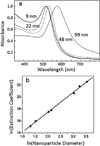Nanoparticle counting: towards accurate determination of the molar concentration
- PMID: 25099190
- PMCID: PMC4188810
- DOI: 10.1039/c4cs00128a
Nanoparticle counting: towards accurate determination of the molar concentration
Abstract
Innovations in nanotechnology have brought tremendous opportunities for the advancement of many research frontiers, ranging from electronics, photonics, energy, to medicine. To maximize the benefits of nano-scaled materials in different devices and systems, precise control of their concentration is a prerequisite. While concentrations of nanoparticles have been provided in other forms (e.g., mass), accurate determination of molar concentration, arguably the most useful one for chemical reactions and applications, has been a major challenge (especially for nanoparticles smaller than 30 nm). Towards this significant yet chronic problem, a variety of strategies are currently under development. Most of these strategies are applicable to a specialized group of nanoparticles due to their restrictions on the composition and size range of nanoparticles. As research and uses of nanomaterials are being explored in an unprecedented speed, it is necessary to develop universal strategies that are easy to use and are compatible with nanoparticles of different sizes, compositions, and shapes. This review outlines the theories and applications of current strategies to measure nanoparticle molar concentration, discusses the advantages and limitations of these methods, and provides insights into future directions.
Figures







References
-
- Daniel MC, Astruc D. Chem. Rev. 2004;104:293–346. - PubMed
-
- Scholl JA, Koh AL, Dionne JA. Nature. 2012;483:421–427. - PubMed
-
- Liu X, Atwater M, Wang J, Huo Q. Colloids Surf., B. 2007;58:3–7. - PubMed
-
- Moreels I, Lambert K, De Muynck D, Vanhaecke F, Poelman D, Martins JC, Allan G, Hens Z. Chem. Mater. 2007;19:6101–6106.
-
- Cheng F-Y, Su C-H, Yang Y-S, Yeh C-S, Tsai C-Y, Wu C-L, Wu M-T, Shieh D-B. Biomaterials. 2005;26:729–738. - PubMed
Publication types
MeSH terms
Grants and funding
LinkOut - more resources
Full Text Sources
Other Literature Sources
Research Materials

